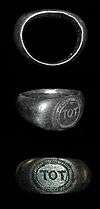Toutatis
Toutatis or Teutates is a Celtic god who was worshipped in ancient Gaul and Britain. On the basis of his name's etymology, he has been widely interpreted to be a tribal protector.[1]
Etymology
Today, he is best known under the name Toutatis (pronounced [towˈtaːtis] in Gaulish[2]) through the Gaulish oath/catchphrase "By Toutatis!", invented for the Asterix comics by René Goscinny and Albert Uderzo. The spelling Toutatis is authentic and attested by about ten ancient inscriptions.[3] Under the spelling Teutates, the god is also known from a passage in Lucan.
The name "Teutates" is derived from the stem teutā-, meaning "people" or "tribe", cognate with the Germanic *þeudō.[4]
Literary evidence
Teutates was one of three Celtic gods mentioned by the Roman poet Lucan in the 1st century AD,[5] the other two being Esus ("lord") and Taranis ("thunderer"). According to later commentators, victims sacrificed to Teutates were killed by being plunged headfirst into a vat filled with an unspecified liquid. Of two later commentators on Lucan's text, one identifies Teutates with Mercury, the other with Mars.
Epigraphic and other evidence

Toutatis was worshipped especially in Gaul and in Roman Britain. Inscriptions to him have been recovered in the United Kingdom, for example that at Cumberland Quarries (RIB 1017), dedicated to Jupiter Optimus Maximus and Mars Toutatis.[6] Two dedications have also been found in Noricum and Rome.[3]
Gallo-Roman interpretation
As noted above, among a pair of later scholiasts on Lucan's work, one identifies Teutates with Mercury and Esus with Mars. At times the Gaulish “Mercury" may have the characteristic of a warrior, while the Gaulish “Mars" may act as a god of protection or healing.
Paul-Marie Duval argues that each tribe had its own toutatis; he further considers the Gaulish Mars the product of syncretism with the Celtic toutates, noting the great number of indigenous epithets under which Mars was worshipped.[1]
TOT finger rings
_(7685561806).jpg)
A large number of Romano-British finger rings inscribed with the name "TOT", thought to refer to Toutatis, have been found in eastern Britain, the vast majority in Lincolnshire, but some in Bedfordshire, Nottinghamshire and Leicestershire. The distribution of these rings closely matches the territory of the Corieltauvi tribe.[7] In 2005 a silver ring inscribed DEO TOTA ("to the god Toutatis") and [VTERE] FELIX ([use this ring] happily") was discovered at Hockliffe, Bedfordshire. This inscription confirms that the TOT inscription does indeed refer to the god Toutatis.[8]
In 2012 a silver ring inscribed "TOT" was found in the area where the Hallaton Treasure had been discovered twelve years earlier. Adam Daubney, an expert on this type of ring, suggests that Hallaton may have been a site of worship of the god Toutatis.[9]
See also
- Interpretatio Romana
- Germanic Mercury
- 4179 Toutatis
References
- Paul-Marie Duval. 1993. Les dieux de la Gaule. Éditions Payot, Paris. ISBN 2-228-88621-1
- Pierre-Yves Lambert (2003). La langue gauloise. Éditions Errance, Paris.
- Listing for Toutatis from www.arbre-celtique.com.
- Proto-Celtic—English lexicon and English—Proto-Celtic lexicon. University of Wales Centre for Advanced Welsh and Celtic Studies. (See also this page for background and disclaimers.) Cf. also the University of Leiden database Archived 2006-02-11 at the Wayback Machine. Proto-Celtic eu generally shifted to ou before the 2nd century BCE. Pierre-Henri Billy. 1993. Thesaurus linguae Gallicae. Olms-Weidmann. ISBN 3-487-09746-X.
- Marcus Annaeus Lucanus. c.61-65 CE. Bellum civile, Book I, ll.498-501. Online translation
- Collingwood, R.Gh. and Wright, R.P. (1965) The Roman Inscriptions of Britain (RIB) Vol.I Inscriptions on Stone. Oxford. RIB 1017, online at romaninscriptionsofbritain.org
- Spicer, Graham (16 July 2007). "Missing Link To Bloodthirsty Ancient Celtic Warrior God Uncovered". Retrieved 2012-08-07.
- "Record ID: BH-C3A8E7 - Roman finger ring". Portable Antiquities Scheme. 3 November 2007. Retrieved 2012-08-07.
- "Rare silver ring unearthed near site of Hallaton hoard". 7 August 2012. Retrieved 2012-08-07.
Sources
- British Museum, London, England.
- Lancaster museum, Lancaster, England.
- Newcastle Museum of Antiquities, Newcastle upon Tyne, England.
- Penrith Museum, Penrith, England.
- Vercovicium Roman Museum, Housesteads Fort, Northumberland, England.
- York Castle Museum, York, England.
- M. Almagro‐Gorbea, A. J. Lorrio Alvarado, Teutates: el héroe fundador, Madrid, Real Academia de la Historia, 2011
Further reading
- Clémençon, Bernard; Ganne, Pierre M. "Toutatis chez les Arvernes: les graffiti à Totates du bourg routier antique de Beauclair (communes de Giat et de Voingt, Puy-de-Dôme)". In: Gallia, tome 66, fascicule 2, 2009. Archéologie de la France antique. pp. 153-169. [DOI: https://doi.org/10.3406/galia.2009.3369] ; www.persee.fr/doc/galia_0016-4119_2009_num_66_2_3369
- Lajoye, Patrice; Lemaître, Claude. "Une inscription votive à Toutatis découverte à Jort (Calvados, France)". In: Etudes Celtiques, vol. 40, 2014. pp. 21-28. [DOI: https://doi.org/10.3406/ecelt.2014.2423] ; www.persee.fr/doc/ecelt_0373-1928_2014_num_40_1_2423

